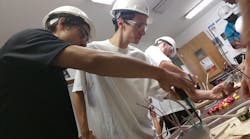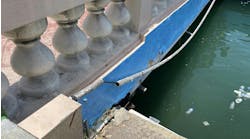As you start your career in the electrical industry as an apprentice, a great way to impress the boss is to display a keen knowledge of your understanding of the basic rules and guidelines around selecting, installing, and protecting conductors. Mastering this vital article in the National Electrical Code (NEC) is essential not only to your job but also to the boss’s peace of mind and the company’s insurance premium. The information presented in Art. 300 can also be found in questions that appear on licensing or journeyman's examinations later in your career. Remember that the provisions in this article do not apply to the internal or integral conductors and components installed (at the factory) by the manufacturer of the electrical equipment, motors, and listed utilization you may be installing or repairing.
The Code gives us specific rules and guidelines to follow on the job site and during the building stages of construction projects. If these rules and guidelines are applied correctly, we can:
- Minimize mistakes and reduce costly errors.
- Ensure the safety of fellow personnel, properties, and users of electricity.
- Install electrical equipment and devices that function correctly and operate safely.
Understanding this section’s importance will keep the company’s insurance claims down and your coworkers safe. It will also build a reputation for precision and reduced service calls among clients and contractors. This column will give you specific guidelines or direct you to the relevant section and part to answer various field-related questions, including the following:
What are the standard trade sizes for conduit, tubing, and associated fittings?
Table 300.1(C), showing metric designators and trade sizes, is beneficial if you’re still learning all of the standard, off-the-shelf conduit, raceway, and fittings for projects of any size or scope. For example, these are the standard sizes for electrical metallic tubing (EMT), rigid polyvinyl chloride conduit, rigid metal conduit, and their fittings used in various types of projects (e.g., residential, commercial, and industrial).
How do I properly protect metallic cables, non-metallic cables, raceways, and conductors?
The guidelines in Sec. 300.4 (A-H) cover running cables over and through wood members and decks; this section also covers notches in joists and bored holes. Here you find the rules for when (steel) nail plates are required to protect non-metallic sheathed cables and non-metallic raceways.
How deep should I install conductors or conduits for underground installations?
Table 300.5 is handy because it lists the minimum cover requirements of 0V to 1,000V for direct-buried cable, conduit, and other raceways that are installed in:
- One- and two-family dwelling driveways;
- Outdoor parking areas;
- Dwelling-related purposes;
- Concrete exterior slabs with no vehicular traffic; and
- Under a building.
How deep should buried service conductors be?
In Sec. 300.5 (D)(3), you will find the guideline for installing directly buried or below-grade single conductors for a main electrical service not encased in concrete. [They must be 18 in. or more below grade and shall have their location identified by a warning ribbon that is placed in the trench at 12 in. above the underground installation.]
What are the rules for securing and supporting raceways, cable assemblies, boxes, cabinets, and fittings above suspended ceilings (e.g., MC cable, flexible metallic tubing, EMT)?
This one is important, so pay attention. According to Sec. 300.11, you must run independent support wires for your installation: “Cables and raceways shall not be supported by ceiling grids or permitted as the sole support.” Your installation must be secure! Support wires must be secured at both ends in addition to the ceiling grid support wires. Remember, the Code was not designed to be convenient or efficient.
How much free conductor or wire length should I leave at a junction box or splice point?
This golden rule is found in Sec. 300.14. Be considerate of the following electrician coming behind you to work. Leave at least 6 in. of free conductor length at each outlet, junction, and switch point for splices or the connection to luminaires or devices. This is measured from the point in the box where the conductor emerges from its raceway or cable sheath jacket. Remember, this is just a minimum requirement; you can leave more, but don't be wasteful.
What type of wiring can I run in plenum-rated ceilings, ducts, or other spaces used for environmental air?
Understanding the guidelines in Sec. 300.22(B) and (C)(1) will keep you out of trouble with local Code enforcement officers (authorities having jurisdiction) and third-party electrical inspectors. [Only wiring methods consisting of a smooth or corrugated impervious metal sheath without an overall non-metallic covering can be used in spaces precisely fabricated to transport environmental air.]
These are a few of the approved wiring methods:
- Electrical metallic tubing;
- Flexible metallic tubing in lengths not to exceed 4 ft.;
- Intermediate metal conduit;
- Rigid metal conduit (without an overall non-metallic covering);
- Type MI cable (without an overall non-metallic covering);
- Type MC cable (without an overall non-metallic covering); and
- Type AC cable.
In closing, electricity demand is on the rise everywhere. Given this reality, the need to work safely also increases. According to data from the Electrical Safety Foundation International, more than 50,000 electrical fires in residential homes occur annually with nearly 500 deaths and more than 1,400 injuries, which equals an estimated cost of property damage of more than $1 billion. Additionally, the U.S. Fire Administration reports that 8,200 fires occurred from an electrical malfunction in 2017, totaling an estimated $431 million in losses.
Electrical equipment failures and malfunctions can be reduced or eliminated by understanding the basic conductor guidelines within the NEC. Take the time to understand the most common causes of electrical fires, and follow the necessary preventive measures. By doing so, you will reduce accidents on the job site and significantly reduce the chance of fire and property damage on your projects.
Follow my column for more practical how-to articles and tips on electric basics and applying those concepts in the field (Everyday Instructions for Electricians, Introduction to Commercial Service Calculations, Introduction to Residential Service Calculations, The Apprentice’s Guide to Non-Metallic Sheathed Cable and The Apprentice’s Guide to NEC Chapter 4). For more information on why a structured approach is so important to navigating the NEC and how to put its requirements into practice in real-world settings, read “The NEC for Newbies.”
Harold De Loach, a master electrician and electrical trainer/instructor, is the founder of The Academy of Industrial Arts (www.taia-school.com) in Philadelphia. With more than 30 years of experience in the field, he writes regular exclusive content for the E-Train and can be reached at [email protected].




